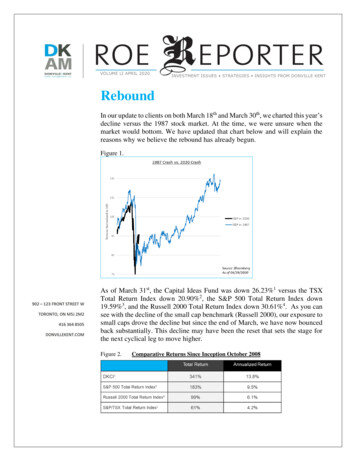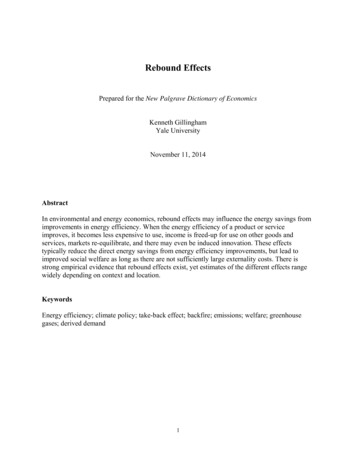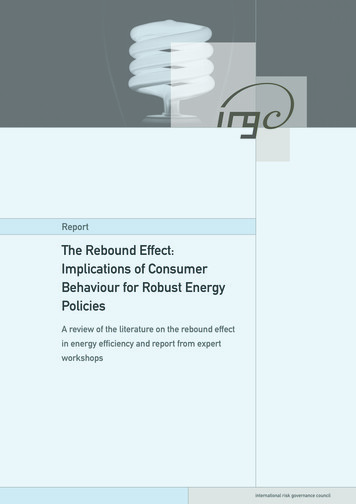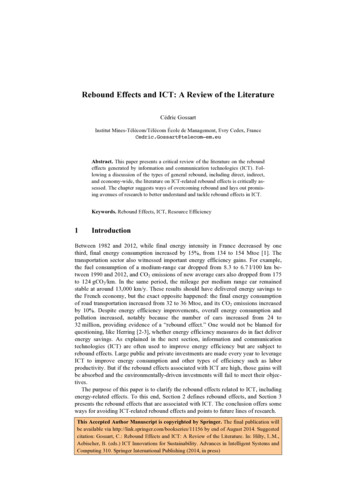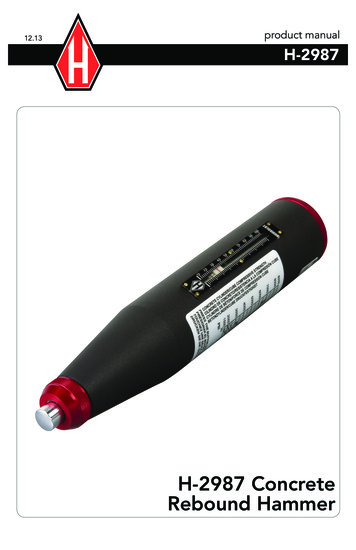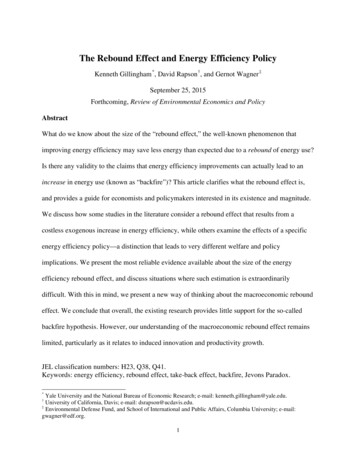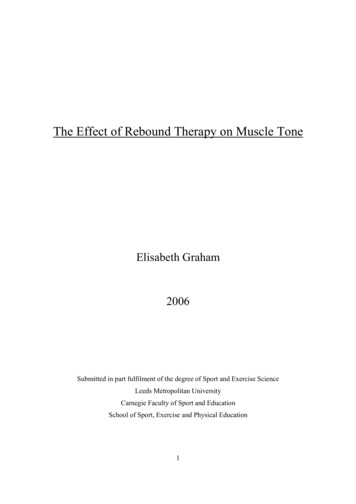
Transcription
The Effect of Rebound Therapy on Muscle ToneElisabeth Graham2006Submitted in part fulfilment of the degree of Sport and Exercise ScienceLeeds Metropolitan UniversityCarnegie Faculty of Sport and EducationSchool of Sport, Exercise and Physical Education1
Contents Page1 Introduction .12 Literature Review .42.1 Defining Muscle Tone42.2 Mechanisms of Muscular Contraction in the Control of Muscle Tone42.3 Maintaining Muscle Tone72.4 Hypertonia82.5 Hypotonia92.6i Improving Muscle Tone10ii Hydrotherapy11iii Therapeutic Horseback Riding122.7 Rebound Therapy142.8 Summary163 Methodology .183.1 Participants183.2 Procedures213.3 Data Analysis254 Results 274.1 Observation274.2 Interview294.3 Questionnaires315 Discussion . 365.1 The Value of Rebound Therapy365.2 Mechanisms to Increase Low Muscle Tone375.3 Mechanisms to Decrease High Muscle Tone395.4 Co-contraction and the Stretch Reflex: Case Study – BL425.5 Newton’s Laws of Motion425.6 Use of Equipment445.7 Strengths and Weaknesses of the Research45i Strengths452
ii Weaknesses45iii Fulfilment of Aims and Objectives466 Conclusion .486.1 Further Research49ReferencesAppendices3
AbstractThis research examines the effect of rebound therapy on the muscle-physiologymechanisms of abnormal muscle tone in neurologically impaired children. Reboundtherapy is a severely under-researched area and in desperate need of clinical andscientific explanations for its effectiveness. As the first study of its kind, in an attempt tohypothesise how rebound therapy improves muscle tone, the triangulation ofmethodologies – namely an interview with an expert rebound therapist, the obtaining ofpractitioners’ opinions of rebound therapy, and observation of neurologically impairedchildren during rebound therapy – has allowed several hypothesised proposals to beexplained in great muscular-physiological detail. These proposals are, in essence fromRollings (2005) who claims that abnormally high muscle tone is reduced because of thevibratory effect on the muscle spindles and that abnormally low muscle tone is increasedbecause of the stimulatory effect upon the sensory systems.Children aged 2 – 5 years (mean age 4.5 1.4 years) with physical disabilities andabnormal muscle tone were observed during rebound therapy and floor-physiotherapy.The types of work the children did was analysed with reference to information obtainedin an interview with a rebound therapy expert. In doing so, the researcher furtheradvocates the use of rebound therapy for physically disabled children, as well assuggesting the underlying mechanisms which may explain why rebound therapy may bebeneficial.The culmination of this study presents the effect of rebound therapy on muscle fibres,specifically explaining how abnormal muscle tone is improved. Decreasing high muscletone has been attributed to shaking of muscle spindles causing muscle lengthening,changes in compressive forces increasing laxity within the muscle fibres and increasedelasticity as a result of the muscle warming up. Increasing low muscle tone has beenattributed to the trampolines ability to shake muscle spindles thus demanding theiractivation, which causes contraction of muscle fibres.4
1: INTRODUCTIONThere are approximately 65,000 children in the UK who have profound and multiplelearning disabilities, many of which are manifested as physical disabilities (Mind, 2006).Children with physical disabilities often develop secondary impairments such as anabnormal level of muscle tone (Goldstein 2005).Muscle tone can be defined as the tension in a relaxed muscle due to involuntarycontractions of its motor units (Tortora and Grabowski, 2003). It is maintainedinvoluntarily, through the activity of the central nervous system. To sustain muscle tone,small groups of motor units are alternatively active and inactive. Abnormal muscle toneis therefore a result of an imbalance between active and inactive motor units, resulting inthe abnormal contraction of muscle fibers. Hypertonia is essentially a result of excessiveinvoluntary contractions; hypotonia results from insufficient involuntary contractions.Muscle tone is fundamentally controlled by activity of the stretch reflex. Muscle spindlesthat activate stretch reflexes by detecting a change in the muscle length, can be adjustedin terms of how vigorously they respond to stretching, thus setting an overall level ofmuscle tone. In some neurologically impaired children, the stretch reflex is unable todetermine the level and strength of the stretch and the child cannot increase or decreasetone as appropriate during movement.Having the ability to control muscle tone is imperative: it is essential in maintainingbalance, posture and head control, and by varying muscle tone, one can execute fine andgross motor skills efficiently. The effects provoked by an improvement in muscle tone –improved posture and an enhanced ability to move more freely, more efficiently and withgreater control – in turn has several beneficial effects to general physical condition andhealth. Physical inactivity, as a result of being physically disabled, stems further muscleatrophy and joint contractures. Over time, muscles and joints adapt to movement capacitycausing deformities and reducing functional capabilities. Movement relieves circulationproblems and reduces the build up of pressure sores – these are inevitable problems for5
physically disabled children during prolonged sitting. Improving muscle tone is ofparamount importance for physically disabled children and it can be improved in severalways including surgery and drugs. However less invasively, physiotherapy is acommonly practiced to reduce abnormal muscle tone.Mayston (2000) highlights the need for the investigation of therapies: they should bebased on sound evidence with a solid explanation of their effect. She claims that there isevidence to support some work which therapists do but there are still many unansweredquestions. Rebound therapy undoubtedly fits with Mayston’s claims.Rebound therapy is a physical therapy which utilises a trampoline in order to develop andpromote motor skills, body awareness, balance, coordination and communication(Rollings 2005). There is no published data into the effectiveness of rebound therapy, andno empirical data to quantify its benefits (Watterstone and Delahunty, 2001; CharteredSociety of Physiotherapy, 2002) yet despite this it is commonly used by SpecialEducation Needs schools, as a means of providing movement and physical experiencesfor those with physical disabilities. It is therefore being done without any scientificevidence.Rebound therapy is a relatively new physical therapy and there has been very littleresearch done into the therapeutic effects of trampolining for people with profound andmultiple learning disabilities (PMLD). As a result, research in this area is very limited(Chartered Society of Physiotherapy, 2002). All of the anecdotal evidence agrees thatrebound therapy improves muscle tone, but this is not supported by any scientificevidence (Watterston and Delahunty, 2001).Rollings’ (2005) claims that abnormally high muscle tone is reduced because of thevibratory effect on the muscle spindles and that abnormally low muscle tone is increasedbecause of the stimulatory effect upon the sensory systems. Although these explanationshave been taken for granted, neither is based on scientific research: both are based onanecdotal evidence and knowledge in the relevant areas.6
This research aims to explain Rollings’ (2005) theories by exploring and examining theeffects of trampolining on skeletal muscle. Because of this severe scarcity of previouslypublished research, reiterating the relevant skeletal muscle physiology forms animperative foundation in understanding muscle tone, hypertonia and hypotonia. Thisinformation is well documented separately but has never been collated within the contextof trampolining. Furthermore, this research aims to triangulate opinion sought fromrebound therapy practitioners, information sought from a rebound therapy expert, andinformation derived from observation of actual rebound therapy sessions and apply this tothe relevant muscle physiology to postulate rebound therapy’s effect on muscle tone.7
2: LITERATURE REVIEW2.1 DEFINING MUSCLE TONEMuscle tone is defined as the tension of a muscle due to involuntary contractions of itsmotor units; it is determined both by the passive elasticity of muscular tissues, the viscoelastic properties of the fibrillary proteins contained within each muscle fibre and by theactive (though not continuous) contraction of muscle in response to the reaction of thenervous system (Tortora and Grabowski, 2003; Basmajan, 1979; Wyke 1976; cited inTaylor, Ellis and Haran, 1995). Muscle tone is a result of both muscular components andneural components: it is the tension in a muscle due to the activity of some muscle fibres,and is controlled by the nervous system (Kent, 2003).Relevant skeletal muscle physiology and the underlying mechanisms of musclecontraction in the control of muscle tone must be first reiterated before examininghypertonia and hypotonia: this is an imperative foundation in understanding why reboundtherapy improves muscle tone.2.2 MECHANISMS OF MUSCULAR CONTRACTION IN THE CONTROL OFMUSCLE TONEContraction is activated by a stimulatory nerve impulse from the central nervous system(CNS) (Appleton, 1997). It triggers an action potential which stimulates the muscle fibre,causing it to contract. A muscle fibre is a single, elongated cell which extends the lengthof the muscle. A muscle is composed of 10,000 to 450,000 muscle fibres (Tortora andGrabowski, 2003): muscle fibre contraction results in muscle contraction.Myofibrils, contained in copious amounts in muscle fibres, are the contractile element ofthe muscle (Tricker and Tricker, 1967). They are contained within the muscle fibre8
cytoplasm and extend the length of the cell (please see Figure 1). Not only can myofibrilscontract, but they can elongate to endure stretching of the muscle.Each myofibril consists of a linked chain of sarcomeres. Sarcomeres containmyofilaments which are chains of contractile proteins. The myofilaments are either thinor thick, and lie in parallel layers, partially overlapping (please see Figures 1 and 2). Thethinner myofilament mainly consists of actin; the thicker myofilament mainly consists ofmyosin.FIGURE 1: The Relationship Between Muscle Fibres, Myofibrils and SarcomeresFigure 1: Taken from Matthews (2004)As proposed by the Sliding Filament Theory (Huxley 1954), muscle contraction occursbecause the thick and thin filaments slide past one another increasing the amount ofoverlap between them (please see Figure 2). Myosin cross-bridges attach onto the actinfilament, rotate towards the centre of the sarcomere, and slide the actin filament towardsthe centre of the sarcomere. The actin layers are anchored to both ends of the sarcomere:9
pulling in of the actin filament subsequently draws in the ends of the sarcomere, reducingits length.FIGURE 2a: A Sarcomere as Proposed by the Sliding Filament Theory – RelaxedSarcomereActinMyosin 1 sarcomereFIGURE 2b: A Sarcomere as Proposed by the Sliding Filament Theory –Contracted SarcomereActinMyosin 1 sarcomere10
Billions of sarcomeres shortening simultaneously results in contraction of the myofibriland because all myofibrils respond together, this causes contraction of the muscle fibre.Because sarcomeres, myofibrils, and muscle fibres all extend longitudinally within themuscle, the contraction and shortening of sufficient sarcomeres causes the entire muscleto contract and shorten in the same direction. It is this contraction which generatestension: without tension, no voluntary movement could take place (Appleton, 1997).When tension develops, the ends of the muscle are drawn in towards the centre whichcauses it to shorten and produce movement (Tyldesley and Grieve, 2002). The increase intension increases tone, which may then instigate movement.2.3 MAINTAINING MUSCLE TONEWhen tone is high, bony points move closer together (Ellis et al., 1995) which is also truewhen observing tension. It can therefore be concluded that increased tension, generatedby increased contraction, increases tone.Muscle tone increases as a result of the increased number of activated myosin crossbridges (Lee et al., 2005). This increases the proportion of actin filament which overlapsthe central myosin myofilament. This results in more contracted muscle fibres whichincreases tension.Muscle tone thus results from neural pathways and the CNS, the number of contractedmuscle fibres and the amount of overlap between actin and myosin myofilaments. Forthis reason, it becomes apparent why children with physical disabilities resulting fromneurological impairments often have abnormal muscle tone: it is an indirect resultant ofabnormal development or damage to motor areas in the brain which disrupt the brainsability to adequately control tone (Cerebra, 2004). Therefore one can postulate that highmuscle tone is a result of excessive tension caused by excessive contraction, and lowmuscle tone is a result of insufficient tension caused by insufficient contractions.11
Muscle tone keeps muscle firm but it does not result in a force strong enough to producemovement. At complete rest, a muscle has not lost its tone although there is noneuromuscular activity in it (Basmajan, 1979). When muscles in the back of the neck arein normal tonic contraction, the head is kept upright. To execute fine motor skills, a lowdegree of contraction is required; to execute gross motor movements, a large degree ofcontraction is required. Muscles thus need to vary their tone (by varying contraction) atcertain times throughout gross movements to ensure smooth movement. The ability toalter muscle tone is therefore very important.2.4 HYPERTONIAHypertonia, or high muscle tone, is described as an abnormal resistance to passivemovement: the resistance has been attributed to muscle, tendon and connective tissueproperties and/or the stretch reflex (Carr et al., 1995). Hypertonia can be defined as aneuromuscular impairment resulting from increased background motor activity. Morespecifically, it is a resultant of abnormal excitability of the components of the stretchreflex arc and excessive abnormal and involuntary contractions of muscle fibresinnervated by the CNS. Hypertonia restricts movement; if muscles surrounding joints arehypertonus the joint can not move to its full range and if the opposing agonist andantagonist muscles are hypertonus, co-contraction occurs.In ‘normal’ muscles co-contraction is prevented by reciprocal inhibition – the processthat inhibits a stretch reflex in the opposing antagonist muscle, causing it to relax. Thestretch reflex is a reflex contraction of the muscle in response to a stretch (Kent, 2003).Stimulation of stretch reflex receptors – muscle spindles – causes a muscle to contract;inhibition of the stretch reflex – via reciprocal innervation – causes a muscle to relax.Therefore, activation of muscle spindles causes contraction of muscle fibres (Tortora andGrabowski, 2003). The stretch reflex provides a feedback mechanism so that duringmovement, muscles can adjust length appropriately (Tyldesley and Grieve, 2002).12
The stimulus for the activation of muscle spindles is a change in the length of muscle(Tyldesley and Grieve, 2002). Muscle spindles respond to stretch and produce a gradedresponse based on its speed and strength (Carr et al., 1995). It is an important mechanismin maintaining muscle tone as it attempts to resist the change in muscle length by causingthe stretched muscle to contract: contraction, thus increasing tone, better controlsmovement. If this reflex is not inhibited or if the reciprocal innervation nerves do notfunction properly, the opposing antagonistic muscle also contracts following the initiationof movement. As a result, movement is neither smooth nor efficient.2.5 HYPOTONIAThere is a scarcity of published work into hypotonia (low muscle tone) (Taylor et al.,1995). Hypotonia is a lack of supportive muscle tone and is usually associated withincreased joint mobility (Rollings, 2005). When motor neurons serving a skeletal muscleare damaged, the muscle becomes flaccid (Tortora and Grabowski, 2003). In comparisonto hypertonia, which is a result of excessive involuntary contraction and activation ofmyosin cross-bridges, hypotonia is fundamentally a result of insufficient involuntarycontractions and scarce activation of myosin cross-bridges. As a result, a limited numberof sarcomeres are contracted to cause muscle fibre contraction: flaccid muscles cannotgenerate much tension. Without tension, movement is difficult.When the body holds a position, muscles are maintained at a constant length by stretchreflex activity. When they change in length, muscle spindles detect these changes andactivate the stretch reflex. The level of stretch reflex is modified throughout movement tochange the settings of the spindle (Tyldesley and Grieve, 2002) resulting in gradedactivation: in the first phase of the stretch, the stretch reflex is rapidly heightened to causeimmediate contraction (in an attempt to prevent injury); as the stretch is prolonged, thespindle slackens and becomes less sensitive to muscle length changes resulting in the rateof contraction to slow. In some neurologically impaired children, if the stretch reflex is13
damaged, it results in an inability of the spindle to detect changes so muscle fibres cannotcontract appropriately in response to the stretch.In hypotonic muscles, the muscle spindle is slack and not sensitive to changes in musclelength. This results in slow activation which makes movement difficult. Children withhypotonic muscles often have difficulty in maintaining balance because their posturaltone is too low. This is especially true while performing fast and accurate movements(Tyldesley and Grieve, 2002) which can be partially attributed to the delayed activationresponse. By contrast, in hypertonic muscles, muscle fibres are already excessivelycontracted and muscle spindles are taut as a result. They are not sensitive to musclelength changes because they are at the height of their activation level (Carr et al., 1995;,Hazlewood, Brown, Rowe and Slater, 1994; cited in Galen and Granat, 1999). Childrenwith hypertonic muscles tend to overshoot movements and have difficulty performingfine motor skills (Tyldesley and Grieve, 2002) which can be partially attributed to theactivation response.2.6 i IMPROVING MUSCLE TONECoupled with the impaired neuromuscular impairment, children with physical disabilitiesalso face further muscle atrophy due to the overall difficulty in exercising (Goldstein,2005). When muscles and joints stay at the same length, as they do during physicalinactivity, joint contractures occur because muscles and joints adapt to movementcapacities. Furthermore, as a result of the abnormal muscle tone and neurologicalimpairment, it is even more difficult for the muscles to stretch. Functional limitations andcan occur if deformities are not prevented (Levitt, 1982).A good level of muscle tone is essential for efficient movement and, by improving thebody’s ability to increase or decrease muscle tone as required, improvements in posture,head control, balance and fine and gross motor skills will also occur. By improvingmuscle tone, a physically disabled child will have greater range and capacity of14
movement which may relieve circulation problems and pressure sores which areprovoked by prolonged sitting. Increasing range of physical ability will also reduceopportunity for joint contractures, muscle atrophy and deformities to occur which in turnincreases functional capabilities and may contribute to improved quality of life. It istherefore of paramount importance to improve muscle tone.Muscle tone can be changed by passively stretching the muscle, thus practicing thestretch reflex. This pressurizes the CNS to initiate contraction and respond to themovement. Prolonging the period of stretch causes muscle spindles to habituate whichconsequently increases the stretch threshold (Appleton, 1994). If stretch reflex inhibitiondoes not occur, co-contraction occurs which is painful.Conventional physiotherapy for children concentrates on the improvement of gross motorfunctions such as balance, crawling, sitting, standing and walking (Hallam, 1997).Physiotherapy can be painful and is often hard work. Many adjunctive therapeuticactivities have been developed as alternatives to traditional physiotherapy (Harris 1978;cited in Cherng et al., 2004).2.6 ii HYDROTHERAPYHydrotherapy is the therapeutic effect of water to treat and aid a variety of conditions,mainly within areas involving the skin, muscles and nerves. It has been claimed topositively impact the motor development of young children (Stein, 2004).The benefits of hydrotherapy are based on the water’s mechanical and thermal effects,exerting a stimulatory pressure to the skin: the feeling of water on the skin may stimulateskin receptors and nerves which increases blood flow and lessens pain sensitivity. Musclespindles may be stimulated in the same way. The constant feeling of water massaging themuscles may arouse slack spindles in hypotonus muscles resulting in increased tone.15
Hydrotherapy uses the beneficial effect of buoyancy which puts less mechanical stress onthe joints than in land based exercises (Kent, 2003; White, 1995). The body’s buoyancyenables children to move independently. Combined with the reduction in gravity, thebuoyancy decreases compressive forces on weight bearing joints which may aidrelaxation, decrease muscle spasm and muscle tension (Koury, 1996; White, 1995). Highmuscle tone may therefore be reduced because there are less compressive forcespressurizing muscle fibres. The warm water also facilitates a decrease in muscle tensionbecause it dilates blood vessels, increasing blood flow to the skin and muscles.2.6 iii THERAPEUTIC HORSEBACK RIDINGIt is hypothesized that therapeutic horseback riding benefits children with motor disorderse.g. cerebral palsy, because of the rhythmic, three-dimensional movement of the horse’swalking which replicates the movement of a human pelvis during walking, thus providinga normal sensorimotor experience (Quint and Toomey, 1998; Riede 1985; cited in Pauw2000).Furthermore, riding horseback continuously changes the relationship between the rider’scentre of mass and their base of support therefore improving coordination andchallenging balance (Cherng et al., 2004). This is further facilitated by changes in thehorse’s stride, velocity and direction which demands stimulation of righting andequilibrium responses (Cherng et al., 2004; Pauw 2000). Balance is defined as themaking of postural adjustments necessary to maintain the alignment between the body’scentre of gravity and the base of support (Reid, 1997; cited in Knox, 2002). It ismaintained by reflexes involving the eyes, structures within the ears, pressure receptors inthe skin and muscle spindles (Kent, 2003). These reflexes communicate via the CNS andbrain to cause increases and decreases in muscle tone (to avoid losing balance): it istherefore dependent on the integrity of muscle tone to respond to the CNS and adaptaccordingly. Understandably, neurologically impaired children find balancing difficult.16
The position of the pelvis plays an important role in efficiency of movement as itinfluences the position of the lumbar spine which affects thoracic and cervical alignment,thus influencing the position of the head and limbs (Quint and Toomey, 1998). Muscletone is important to keep the body in alignment (Tyldesley and Grieve, 2002) and so theinability to align oneself may also be equally due to abnormal muscle tone. Quint andToomey (1998) found that cerebral palsied subjects who rode a mechanical saddle, thusreplicating horse riding, significantly increased their passive range of antero-posteriorpelvic tilt compared to those who sat on a static saddle. However both groups of childrenincreased their range of pelvic movement, which suggests that the astride position(flexion and abduction of the hip joint) may also contribute to the benefits, rather than therhythmic, three-dimensional movement alone. They deduced that the pelvic movementhindered hypertonia.Sitting positioned with the hips abducted reduces electromyogram (EMG) activity in thehip adductors, knee extensors, plantar flexors and back extensors (Quint and Toomey,1998). A reduction in electrical activity in muscles may indicate a reduction in the neuralfactors contributing to muscle tone. The astride sitting posture in THR – where the hipsare flexed and abducted – may therefore reduce hypertonia. There is no objectiveevidence which demonstrates that THR improves muscle tone, but Bertoti (1988; cited inCherng et al., 2004) subjectively concluded decreased hypertonicity in his spasticcerebral palsied subjects. However, a study which examined the effect of THR on muscletone in the hip adductors using the modified Ashworth Scale, found no significantimprovement (Cherng et al., 2004). The studies did show improved standing posture(Bertoti, 1988) and improved walking ability when measured using the Gross MotorFunction Measure (Cherng et al., 2004), which improved muscle tone may havecontributed to.17
2.7 REBOUND THERAPYRebound therapy may benefit children with physical disabilities for many of the samehypothesized reasons as therapeutic horseback riding and hydrotherapy. It can provide anunstable surface, provoke feelings of weightlessness and induce a rhythmic, threedimensional movement.Similarly to THR, rebound therapy provides constant opportunity for sensory integrationof kinesthetic, visual, and vestibular input. The vestibular sensory system, whichresponds to changes in head position, body movement and the pull of gravity, isheightened in rebound therapy because of the vertical motions of the body on thetrampoline (Rollings, 2005; Noda et al., 2003).Noda et al., (2003) reported noticeable improvements in the clinical conditions ofpermanent vegetative state patients following musicokinetic therapy (passive trampolinebouncing to music). They attributed the improvements to stimuli simultaneouslyactivating vestibular, somatosensory and motor pathways and functions within the brain.This is consistent with the hypothesis that such stimuli from the environment could helprestore awareness (Noda et al., 2003). This suggests that rebound therapy can alsoheighten awareness and brain activity for neurologically impaired children, and this effectmay be further exaggerated as they can take in more sensory information than thepermanent vegetative state patients.In a pilot study which – and by the authors own admissions was ‘born out of thefrustrations for a lack of evidence available to support rebound therapy’ – investigatedthe use of rebound therapy for patients with learning disability, it was concluded that thetherapy’s is an effective means of improving physical disability (Watterston andDelahunty, 2001). The research monitored and evaluated physical condition of fivepatients over eighteen months, using a five area function assessment which was testedbefore and after the rebound therapy course. All individuals made progress and there wasa 41% group average improvement in physical condition. Because the participants were18
not experiencing any other therapy, this adds further support for the use of reboundtherapy. The function assessment evaluated subjects in transfer onto the trampoline, andability to sit, kneel, stand and bounce. This was assessed using a five point scale but incriticism of the research, a ceiling effect limited the results.In a preliminary study which highlighted the benefits of rebound therapy, Hartley andRushton, (1984) reported remarkable improvements in cerebral palsied children’sphysical conditions. The study’s methodology was observational: with no previousresearch claiming ‘best practice’, the therapist-researchers relied on trial and error tomonitor the program and responses of twenty-four children, all with similar motorfunction problems. The children received twice weekly rebound therapy for six months.The research found that rebound therapy reduced hypertonia, but made no claim as to itseffect on hypotonia. All results were based on subjective observation and muscle tonewas measured by ‘feel’. This opens the research up to criticism regarding researcher biasand lack of statistical evidence to demonstrate its improvement.In hemiplegic children, weight bearing on the effected side improved, and bodyawareness and posture improved. In spastic quadriplegic children, Hartley and Rushton,(1984) reported reduced adductor spasm, increased range of pain free adduction anddiminished symmetrical tonic neck reflex. Furthermore, all children showed animprovement in trunk and pelvis control, and equilibrium reactions and balance.However, in a study which examined balance training in hemiplegic patients, the use ofthe trampoline was reported not to offer any special advantages to balance mechanisms(Era et al., 1991).The astride sitting position in THR has been concluded to reduce muscle tone in hipadductors, knee extensors, plantar flexors and back extensors (Quint and Toomey, 1998).In addition, this sitting position combined with a rhythmic, three-dimensional movement,significantly improved pelvic range of movement when compared to sitting statically inthe position (Quint and Toomey, 1998). Rebound therapy can replicate these beneficialconditions by sitting astride a soft-play cylinder roll whilst being bounced. Furthermore,19
adjustment to th
Rebound therapy undoubtedly fits with Mayston's claims. Rebound therapy is a physical therapy which utilises a trampoline in order to develop and promote motor skills, body awareness, balance, coordination and communication . (Kent, 2003). Relevant skeletal muscle physiology and the underlying mechanisms of muscle


